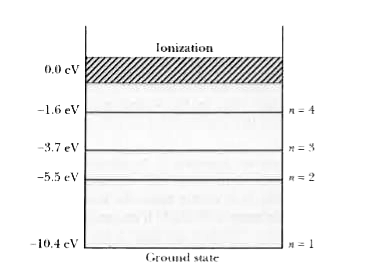Fig shows that energy levels of a mercury atom. Electrons with kinetic energies of 7.0 eV are introduced into mercury vapor. (a) Convert the energy levels to the system that sets the ground state at 0 eV. (b) What is the kinetic energy of an electron after an elastic collision with a mercury atom? (c ) What are the possible kinetic energies of an electron after an inelastic collision with a mercury atom? (d) What are the energies of the photons coming from the mercury vapor?

(a) 0 eV, 4.9 eV, 6.7 eV, 8.8 eV and so on, (b) 7 eV, (c ) 2.12 eV, 0.3 eV, (d) 6.7 eV, 4.9 eV, 1.8 eV
Topper's Solved these Questions
- ALL ABOUT ATOMS BOOK - RESNICK AND HALLIDAYCHAPTER - ALL ABOUT ATOMS EXERCISE - PRACTICE QUESTIONS (SINGLE CORRECT CHOICE TYPE)
57 Videos
- ALL ABOUT ATOMS BOOK - RESNICK AND HALLIDAYCHAPTER - ALL ABOUT ATOMS EXERCISE - PRACTICE QUESTIONS (MORE THAN ONE CORRECT CHOICE TYPE)
4 Videos
- ALL ABOUT ATOMS BOOK - RESNICK AND HALLIDAYCHAPTER - ALL ABOUT ATOMS EXERCISE - CHECKPOINT
1 Videos
- CAPACITANCEBOOK - RESNICK AND HALLIDAYCHAPTER - CAPACITANCEEXERCISE - PRACTICE QUESTION (INTEGER TYPE)
3 Videos
Similar Questions
Knowledge Check
The total energy of the electron in the first excited state of hydrogen is −3.4eV. What is the kinetic energy of the electron in this state?
A+1.7eVB+3.4eVC+6.8eVD−13.4eVIf potential energy of an electron in a hydrogen atom in first excited state is taken to be zero kinetic energy (in eV) of an electron in ground state will be
A20.4eVB10.2eVC3.4eVD5.1eVAn α-particle with a kinetic energy of 2.1eV makes a head on collision with a hydrogen atom moving towards it with a kinetic energy of 8.4eV. The collision
Amust be perfectly elasticBmay be perfectly inelasticCmay be inelasticDmust be perfectly inelastic
If potential energy of an electron in a hydrogen atom in first excited state is taken to be zero kinetic energy (in eV) of an electron in ground state will be
View SolutionThe energy of the electron in the ground state of hydrogen atom is −13.6eV. Find the kinetic energy and potential energy of electron in this state.
View SolutionThe energy of the electron in the ground state of hydrogen atom is −13.6eV. Find the kinetic energy and potential energy of electron in this state.
View SolutionThe ground state energy of hydrogen atom is-13.6 eV. What are the kinetic and potential energies of the electron in this state ?
View SolutionThe energy of the electron in the ground state of hydrogen atom is −13.6eV. Find the kinetic energy and potential energy of electron in this state.
View Solution
